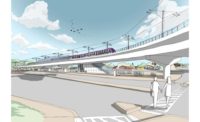"We did put in a lot of underdrain systems to drain our tracks, especially with all of the asphalt out there," Zucker says. "It can cause a bathtub effect."
More than 23 buildings are being constructed during Phase 2, although some of the structures are only buildings in the sense that they have four walls and a roof. Zucker says there are some structures that will be rarely—if ever—inhabited.
"It is hard to define buildings out here because not all of them are occupied," he says.
The yard office and intermodal facility are designed for LEED-Silver certification. The crew change buildings will serve as home base for Union Pacific employees operating long-haul trains out of the area. The intermodal ramp will be regionally focused and will permit both local and regional businesses more immediate access to the efficiencies of freight trains.
The crown jewel of the yard is the driving force behind its very development: the two refueling and maintenance stations. Positioned on the east and west sides of the site—about two miles apart—the stations will provide fuel and fluid/maintenance services for trains. Effluent will be unloaded at the stations, and water and other necessities will be provided.
The above-ground tanks are fed by a nearby interstate pipeline that was extended to the site during Phase 1.
Building For the Future
On such a large project that is spread over so much distance, it's not like many vertical construction projects that have an official turnover date. Rather, it is more like a checklist process.
"It's such a large facility, it's not just like turning on a switch. Some folks are already out there kicking the tires, but on the construction it is still wrapping up," Richmond says. "We are not like a Wal-Mart or Target."
As such, some operational activities have begun, including crew changes and fueling on some locomotives. Other parts of the facility, such as the intermodal facility, are still in progress.
The overall economic impact of the Strauss Rail Yard on the New Mexico economy is estimated at $500 million. The facility will have created approximately 3,000 jobs by the end of the construction phase in 2015 and will eventually be the headquarters for more than 600 permanent jobs.
With more than 50 contractors involved in the current portion of the project, there is an average of 350 workers on site daily. Of the current subcontractors, about 40% are from New Mexico.
For years into the future—perhaps a century—Strauss Rail Yard will provide a key inland port and a strategic focal point for Union Pacific in the Southwest U.S.







Post a comment to this article
Report Abusive Comment